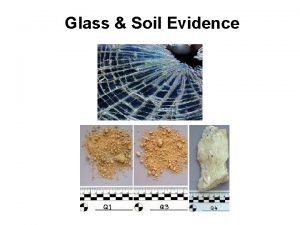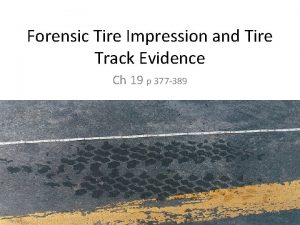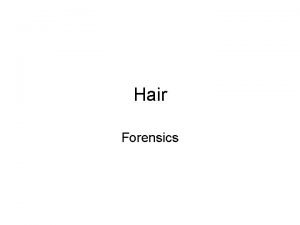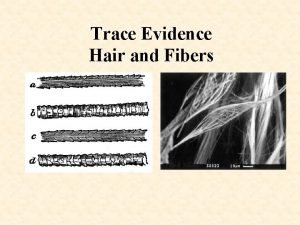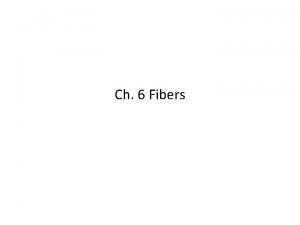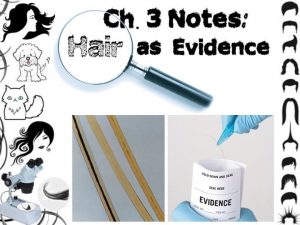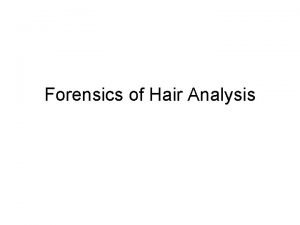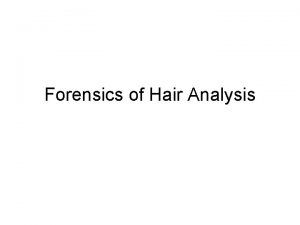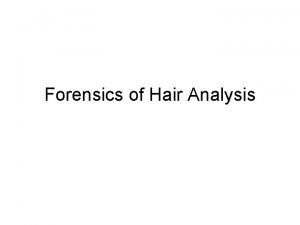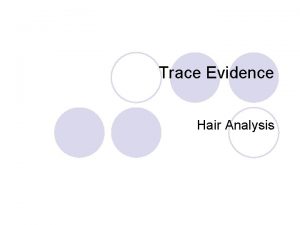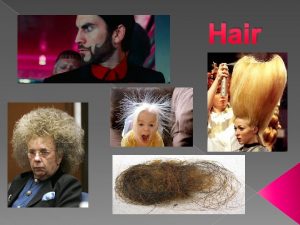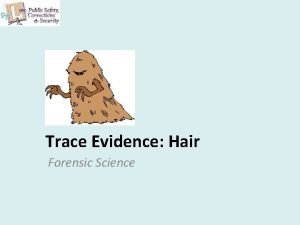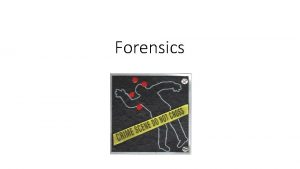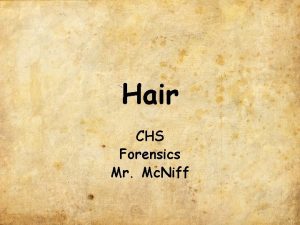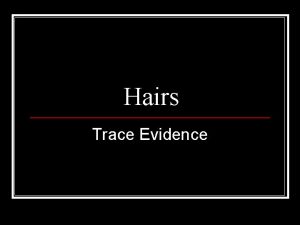Hair Forensics Hair is physical evidence Forensic characteristics

































- Slides: 33

Hair Forensics

Hair is physical evidence • Forensic characteristics of hair: – Color – Structure – Morphology • It is not possible to individualize human hair

Structure of Hair • Hair is an appendage of the skin – Hair grows out of the hair follicle organ – The hair extends from the root embedded in the follicle, continues into a shaft and terminates at the tip end


Hair Identification • Important features: – Cuticle scale structure – Medullary index – Medullary shape • Other features: color, length, diameter; distribution, shape, color intensity of pigments • Comparison microscope is an invaluable tool

Hair Shaft • Used for most intense examination • Composed of 3 layers – Cuticle – Cortex – Medulla

Cuticle • Outside covering of the hair – Makes hair resistant to chemical decomposition and makes it able to retain structural features over time – Structure: • Overlapping scales that point towards the tip end of each hair • Different species have different scale patterns

Cuticle • View the cuticle with a: – Scanning electron microscope – Cast of the hair’s surface and view under a compound microscope

Cuticle – Scale Patterns • 3 types of patterns – Coronal: small rodents and bats but rarely in human hairs – Spinous: mink, seals, cats, and are never found in humans – Imbricate: human hairs and many animal hairs

Cuticle – Scale Pattern • Rabbit

Cuticle – Scale Pattern • Deer

Cuticle – Scale Patterns • Human

Cuticle – Scale Patterns • Dog

Cuticle – Scale Patterns • Cat

Cuticle – Scale Patterns • Mouse

Medulla • Looks like the central canal running through a hair – More than half of the hair’s diameter – Medullary index: measure of the diameter of the medulla relative to the diameter of the hair shaft (fraction) • Humans: usually less than 1/3 • Most other animals: ½ or greater • Presence and appearance varies from individual to individual and even among the hairs of a given individual

Human Medullary Index 0. 53 nm 1. 59 nm

Medulla • 4 ways to classify: – Continuous • Most animals, Some humans (Asians) – Interrupted • Most animals – Fragmented • Humans – Absent • Humans

Medulla • Shape – Cylindrical shape: humans & many animals – Various shapes for some animals • Searchable database for 35 common animal hairs encountered in forensic casework

Medulla - Patterns • Rabbit

Medulla - Patterns • Deer

Medulla - Patterns • Human

Medulla - Patterns • Dog

Medulla - Pattern • Cat

Medulla - Patterns • Mouse

Hair Identification - Race • 1 st: Distinguish between animal vs. human • 2 nd: Identify race – Asian: wider diameter than the hairs of the other racial groups, thicker cuticle, continuous and wide medulla, larger pigment granules

Hair Identification - Race • African: largest pigment granules and are grouped in clumps of different sizes and shapes. • Caucasian: evenly distributed pigment granules.

Hair Identification – Body Area • Head: uniform diameter and usually a cut tip • Pubic hair: coarse and wiry, exhibit considerable diameter variation or buckling, often have a continuous to discontinuous medulla

Root • Shows if hair was removed with force

Can we tell if hair was dyed? • Yes! – Color will appear in cuticle and cortex – Bleach removes pigment – Estimate time since dyeing or bleaching: • Hair grows at approximately 1 cm per month

Damaged Hair

Special Characteristics

Collection & Packaging • Collect at least 50 full length head hairs from all over the scalp • Collect at least 24 full length pubic hairs from all pubic areas • Method: Pull hair out of skin, clip near skin line, or vacuum up
 Circumstantial variability
Circumstantial variability What characteristics make hair a useful forensic tool
What characteristics make hair a useful forensic tool Pathologist and anthropologist
Pathologist and anthropologist Forensic psychiatry vs forensic psychology
Forensic psychiatry vs forensic psychology Conditional evidence example
Conditional evidence example Forensic recovery of evidence device
Forensic recovery of evidence device Glass evidence in forensic science
Glass evidence in forensic science How to maintain a qualified forensic duplicate
How to maintain a qualified forensic duplicate Kathleen peterson forensic evidence
Kathleen peterson forensic evidence Forensic evidence
Forensic evidence Tire track evidence
Tire track evidence Morphology forensics
Morphology forensics Hair follicle definition forensics
Hair follicle definition forensics Human hair pattern
Human hair pattern Forensics
Forensics Prof randanan bandaso
Prof randanan bandaso Primary evidence vs secondary evidence
Primary evidence vs secondary evidence Primary evidence vs secondary evidence
Primary evidence vs secondary evidence Primary evidence vs secondary evidence
Primary evidence vs secondary evidence Primary evidence vs secondary evidence
Primary evidence vs secondary evidence Primary evidence vs secondary evidence
Primary evidence vs secondary evidence Why are fibers considered class evidence
Why are fibers considered class evidence Class vs individual evidence
Class vs individual evidence Class evidence can have probative value.
Class evidence can have probative value. Class and individual evidence
Class and individual evidence The ecological fallacy
The ecological fallacy Trace evidence hair
Trace evidence hair Are fibers class or individual evidence
Are fibers class or individual evidence Three basic scale patterns hair
Three basic scale patterns hair Medulla pattern with one unbroken line of color
Medulla pattern with one unbroken line of color What makes hair evidence valuable
What makes hair evidence valuable Direct vs circumstantial evidence
Direct vs circumstantial evidence Is hair class or individual evidence
Is hair class or individual evidence Medulla pattern with one unbroken line of color
Medulla pattern with one unbroken line of color






